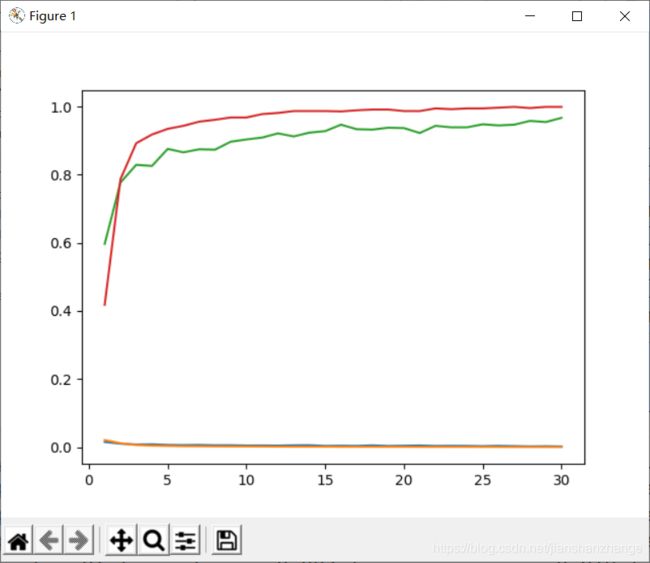基于pytorch的四种天气分类含Dropout层和BN层
import torch
import torch.nn as nn
import pandas as pd
import numpy as np
import matplotlib.pyplot as plt
import torch.nn.functional as F
import torchvision
import time
import os
import shutil
from torchvision import datasets,transforms
from torch.utils.data import TensorDataset
from torch.utils.data import DataLoader
from sklearn.model_selection import train_test_split
start=time.time()
base_dir = r'D:/pycharmworkspace/ISLR-master/fourweather'
#如果base_dir不是文件目录
if not os.path.isdir(base_dir):
#就创建base_dir这个目录
os.mkdir(base_dir)
#在base_dir目录基础上再建train目录,下同
train_dir = os.path.join(base_dir,'train')
test_dir = os.path.join(base_dir, 'test')
os.mkdir(train_dir)
os.mkdir(test_dir)
specises=['cloudy','rain','shine','sunrise']
#继续循环创建目录
for train_or_test in ['train','test']:
for spc in specises:
exist = os.path.join(base_dir,train_or_test,spc)
if not os.path.isdir(exist):
os.mkdir(os.path.join(base_dir,train_or_test,spc))
#图片原始存放目录
image_dir = r'D:/pycharmworkspace/ISLR-master/4w'
#os.listdir(image_dir)会把图片列举出来
#利用enumerate则i为0 img为第一张图片,i为1 img为第二张图片
for i,img in enumerate(os.listdir(image_dir)):
for spec in specises:
#字符串判断
if spec in img:
s = os.path.join(image_dir,img)
#4/5数据分到train目录
if i%5 == 0:
d = os.path.join(base_dir,'test',spec,img)
#1/5数据分到test目录
else:
d = os.path.join(base_dir, 'train',spec,img)
#将数据从s路径拷贝到d路径
shutil.copy(s,d)
#分割线----------------------以上是数据移动的内容---------------------------
#将所有变换都以列表形式放在Compose里面
transformation = transforms.Compose([
#将图片切割为96*96的大小
transforms.Resize((96,96)),
#将读取的图片或者其他类型的数据转换成Tensor
#将Tensor转换到0到1之间
#会将channel放在第一维度上
transforms.ToTensor(),
#将Tensor转换到-1到1之间
transforms.Normalize(mean=[0.5,0.5,0.5],std=[0.5,0.5,0.5])
])
#分割线----------------------以上是数据设置的内容---------------------------
#ImageFolder可以从分类的文件夹中创建dataset数据
#比如下雨的图片在一个文件夹 多云的图片在一个文件夹等
train_ds = torchvision.datasets.ImageFolder(
#即train_dir
os.path.join(base_dir,'train'),
transform=transformation
)
test_ds = torchvision.datasets.ImageFolder(
#即test_dir
os.path.join(base_dir, 'test'),
transform=transformation
)
#常量大写
BATCHSIZE=64
train_dl = torch.utils.data.DataLoader(
train_ds,
batch_size=BATCHSIZE,
shuffle=True,
)
test_dl = torch.utils.data.DataLoader(
train_ds,
batch_size=BATCHSIZE,
)
#通过iter()函数获取这些可迭代对象的迭代器
#对获取的迭代器不断使用next()函数来获取下一条数据
imgs,labels=next(iter(train_dl))
#print(imgs.shape)
##输出的是torch.Size([64, 3, 96, 96]) 64是图片张数 3是通道(图层)即彩色 [···96个数据···] 共96个[]
#在pytorch里面图片的表示形式:[batch,channel,hight,width]
#分割线----------------------以上是数据预处理的内容---------------------------
# print(train_ds.classes)
# #输出的是['cloudy', 'rain', 'shine', 'sunrise']
# print(train_ds.class_to_idx)
# #输出的是{'cloudy': 0, 'rain': 1, 'shine': 2, 'sunrise': 3}
# id_to_class = dict((v,k) for k,v in train_ds.class_to_idx.items())
# print(id_to_class)
# #输出的是{0: 'cloudy', 1: 'rain', 2: 'shine', 3: 'sunrise'}
# plt.figure(figsize=(12,8))
# for i,(img,label) in enumerate(zip(imgs[:6],labels[:6])):
# img = img=img.permute(1,2,0).numpy()+1
# plt.subplot(2,3,i+1)
# plt.title(id_to_class.get(label.item()))
# plt.imshow(img)
# plt.show()
#分割线----------------------以上是额外学习的内容---------------------------
device = torch.device("cuda:0" if torch.cuda.is_available() else "cpu")
class Net(nn.Module):
# 定义初始化方法
def __init__(self):
# 继承父类所有属性
super().__init__()
#彩色图片故输入channel为3 16为卷积核个数则会形成16通道(图层) 3为3*3的卷积核.
#nn.Conv2d()适合图片
self.conv1 = nn.Conv2d(3,16,3,)
#nn.BatchNorm2d()适合图片 16是上一层的输出
self.bn1 = nn.BatchNorm2d(16)
self.conv2 = nn.Conv2d(16,32,3,)
self.bn2 = nn.BatchNorm2d(32)
self.conv3 = nn.Conv2d(32,64,3,)
self.bn3 = nn.BatchNorm2d(64)
#droput是随机丢弃掉一部分神经元(的输出)来抑制过拟合
#添加Dropout层
#nn.Dropout()适合Linear
self.drop = nn.Dropout(0.5)
#nn.Dropout2d()适合图片
self.drop2d = nn.Dropout2d(0.5)
#nn.Dropout2d()适合三维数据
self.pool = nn.MaxPool2d((2, 2))
self.fc1 = nn.Linear(64*10*10,1024)
self.bn_f1 = nn.BatchNorm1d(1024)
self.fc2 = nn.Linear(1024,256)
self.bn_f2 = nn.BatchNorm1d(256)
self.fc3 = nn.Linear(256, 4)
def forward(self, input):
x = F.relu(self.conv1(input))
x = self.bn1(x)
x = self.pool(x)
x = F.relu(self.conv2(x))
x = self.bn2(x)
x = self.pool(x)
x = F.relu(self.conv3(x))
x = self.bn3(x)
x = self.pool(x)
x = self.drop2d(x)
#print(x.shape)
#会输出torch.Size([64, 64, 10, 10])
x = x.view(-1,64*10*10)
x = F.relu(self.fc1(x))
x = self.bn_f1(x)
#Dropout一般在BN层之后
x = self.drop(x)
x = F.relu(self.fc2(x))
x = self.bn_f2(x)
x = self.drop(x)
x = self.fc3(x)
return x
#分割线----------------------以上是定义神经网络的内容---------------------------
model = Net()
model = model.to(device)
loss_fn = torch.nn.CrossEntropyLoss()
optim = torch.optim.Adam(model.parameters(),lr=0.0001)
epochs = 30
def fit(epoch,model,trainloader,testloder):
#下面三个是个数不是概率
correct = 0
total = 0
running_loss = 0
#Dropput在训练的时候回随机丢弃神经元(的输出),但预测的时候不会
#model.train()是训练模式,想让Dropout发挥作用,对BN层也有用
model.train()
for x,y in trainloader:
#将训练数据也放到GPU上
x = x.to(device)
y = y.to(device)
y_pred = model(x)
loss = loss_fn(y_pred, y)
# 梯度置为0
optim.zero_grad()
# 反向传播求解梯度
loss.backward()
# 优化
optim.step()
# 不需要进行梯度计算
with torch.no_grad():
#torch.argmax将数字转换成真正的预测结果
y_pred = torch.argmax(y_pred, dim=1)
#计算个数
correct += (y_pred == y).sum().item()
total += y.size(0)
running_loss += loss.item()
#除以的是总样本数 trainloader.dataset是形参,实参是train_dl即train_dl.dataset
#train_dl.dataset指向的是train_ds
epoch_loss = running_loss/len(trainloader.dataset)
epoch_acc = correct/total
test_correct = 0
test_total = 0
test_running_loss = 0
#model.eval()是预测模式,不让Dropout发挥作用,对BN层也有用
model.eval()
with torch.no_grad():
for x,y in testloder:
#将测试数据也要放到GPU上
x = x.to(device)
y = y.to(device)
y_pred = model(x)
loss = loss_fn(y_pred,y)
y_pred = torch.argmax(y_pred, dim=1)
test_correct += (y_pred == y).sum().item()
test_total += y.size(0)
test_running_loss += loss.item()
epoch_test_loss = test_running_loss / len(test_dl.dataset)
epoch_test_acc = test_correct / test_total
print('epoch: ',epoch,
'train_loss: ',round(epoch_loss,3),
'train_accuracy: ',round(epoch_acc,3),
'test_loss: ',round(epoch_test_loss,3),
'test_accuracy: ',round(epoch_test_acc,3)
)
return epoch_loss,epoch_acc,epoch_test_loss,epoch_test_acc
#分割线----------------------以上是定义学习函数的内容---------------------------
#便于随着训练的进行观察数值的变化
train_loss=[]
train_acc=[]
test_loss=[]
test_acc=[]
for epoch in range(epochs):
epoch_loss,epoch_acc,epoch_test_loss,epoch_test_acc = fit(epoch,model,train_dl,test_dl)
train_loss.append(epoch_loss)
train_acc.append(epoch_acc)
test_loss.append(epoch_test_loss)
test_acc.append(epoch_test_acc)
end = time.time()
print(end-start)
plt.plot(range(1,epochs+1),train_loss,label='train_loss')
plt.plot(range(1,epochs+1),test_loss,label='test_loss')
plt.plot(range(1,epochs+1),train_acc,label='train_acc')
plt.plot(range(1,epochs+1),test_acc,label='test_acc')
plt.show()
#分割线----------------------以上是最终运行的内容---------------------------
添加Dropout层未添加BN层结果如图所示

添加Dropout层且添加BN层结果如图所示
Dropput层应该在BN层之后!!!

